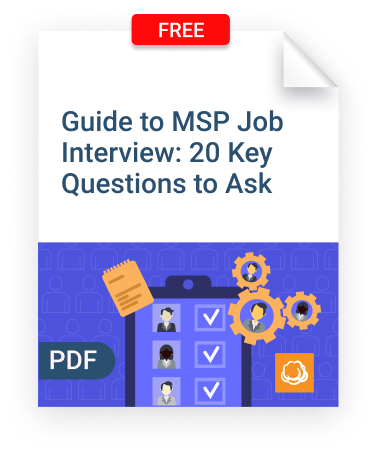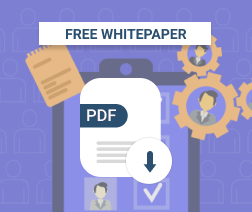The successful onboarding of a new hire depends as much on the hiring party as it does on the new employee. When employees don't fit, it costs irreplaceable time and money. Using proven onboarding processes can help prevent this from happening. Keep reading to learn about the technician onboarding process and get the proven onboarding techniques that will help you to land a new MSP employee successfully.
Pre-onboarding Process
The technician onboarding process starts, naturally, with making the right hire. Hiring managers need to know how to list the position, what to look for during an interview, and how to recognize red flags. Here's how to get started with finding new technicians.
A Listing That Gets Results
The way that the job is listed determines the hiring pool. Each listing should include the following:
1. A strong description - Technicians on the hunt for a job need to understand what the job entails. Be sure that the description gives enough detail so that only interested parties apply.
2. Skill sets needed - In the technical world, listing specific skill sets is a quick way to narrow down the hiring pool. In most cases, applicants that do not meet each skill set need not apply.
3. Experience required - Is this an entry-level position, or is a grizzled veteran needed? Make sure this is outlined.
Further reading MSP Hiring Funnel: How It Works
What to Look For in a New Technician
Some skills are harder to train than others. Keep this under consideration, and look out for some specific qualities in the interview process:
1. Well-spoken - Technicians for managed service providers are going to be spending a lot of time communicating with clients.
2. Basic troubleshooting knowledge - Figuring out solutions to technical issues is sometimes more about the approach than prior knowledge. Strong troubleshooting will lead to shorter call times and happier clients.
3. Respectful - Interviewees who are polite and courteous in an interview will also often be the same to customers.
Further reading Best Certifications for IT Pros
Interview Process Red Flags
While working through an interview, there are a few red flags to look for that should potentially rule someone out immediately. Here are a few things to look out for:
1. Foul language - Although this may not offend the interviewer directly, it could offend customers. If they feel comfortable cursing during an interview, they will feel comfortable doing it with a customer as well.
2. Cutting off the interviewer - Interrupting is rude and shows subconscious disrespect for the interviewer. This could be an indication of how they would be as an employee.
3. Discrimination - Making generalizations about any specific group is not only offensive, but it could lead to future harassment lawsuits down the road.

A Technician’s First Day
Navigating an employee's first day in the best way possible helps set the tone for the rest of the first week, and the rest of the employee’s tenure. Here’s how to get started with the new technician onboarding process.
The Big Introduction
The new employee should get acquainted with the team. Team members should also take a few minutes of distraction to say hello and give a hearty welcome. This establishes immediate buy-in from the new hire.
Building Confidence Throughout
Technicians shouldn’t be put on phones until they have had some time to shadow more-experienced employees. They should also be given a strong introduction to the ticketing system and understand how the team works together. This will help the new hire to know that they are in the right place.
Ending the Day Strong
As a vital part of the technician onboarding, hiring managers should schedule an end-of-day sit-down with new hires to make sure that they were comfortable with their introduction to the company and to see if they have any questions about their first day. The new employee should have a general understanding of what their day-to-day will be like, as well as the people that they will be working with.
Further reading Want to Keep Your Employees Happy? Ask Yourself These Three Questions
Developing a New-Technician Training Program
Job shadowing and one-on-one training are vital, but they should not be the only ways that a new technician learns the trade. A learning management system should be established, so that managed service providers can see that new employees are all trained similarly.
What to Cover
Every managed service provider needs to write a learning management system specific to their own needs. While each will be unique, here are a few items that they should cover.
1. Ticketing system - Each MSP handles its ticket process in its own way. New hires must understand company norms and policies.
2. In-house system management - Technicians that are hired to handle internal IT should know the company standards for the in-house system. This includes the network hierarchy and a list of servers.
3. Naming conventions - Every managed service provider will have its own naming system in place for its devices. The learning management system should make this clear so that everyone is on the same page.
Tone and Style
The learning management system should be written in a manner that makes it usable for anyone who may need it.
The best way to verify that the tone and style fit all situations is with a solid quality review. New hires and senior technicians alike should be allowed to review all documentation. It should also be checked through by a non-technical documentation specialist.
Further reading On Training Employees: Is it Worth the Risk?
Continual Updates
Here are a few ways to make sure that the learning management system is always current.
1. Document all new processes - As new processes are established, they should be immediately documented and added to the learning management system. This is also a good time to remove outdated processes.
2. Coordinate quarterly reviews - A documentation specialist should be assigned to review the learning management system on a quarterly basis.
3. Have an update request system - When an employee finds a need to change or update the learning management system, there should be an easy way to submit updates.
Technician’s First Year
Tracking the progress of your new hires is a vital part of the technician onboarding that will help to make key decisions on their place within the company moving forward. Here’s how best to prepare for the first year.
How to Set Goals
Setting expectations is the best way to build a mutual understanding between management and new hires. Each stage transitions further from positional to personal - ending with an end-of-year review.
Here are the three stages of setting goals.
1. Have standard positional goals to start - This list should be established by management and human resources.
2. Tweak positional goals after the first month - Review where the employee is within the position and how they are trending. This should be a low-pressure overview to make sure the new hire is pointed in the right direction.
3. Set personal goals after three months - At this point, management should have a decent understanding of the new hire, and whether they are trending in the right direction. Make goals more personal, to be reviewed at the end of the first year.
Further reading 5 Actions MSPs Can Take to Retain Top Talent
How to Review the First Year
The technician’s first year, and every year thereafter, should end with a formal review. It should involve a scheduled sit-down with the employee and their direct manager. A report should be provided to the employee that reviews the previous year’s performance and sets new goals for the next year.
Conclusion
When a managed service provider hires a new employee, they are investing in the future of the company. Bringing in new hires in the right way helps to ensure the safety and efficiency of the investment. Following these steps for new technician onboarding is the best way to handle this.






